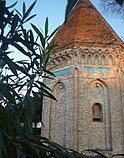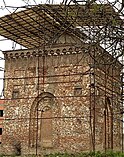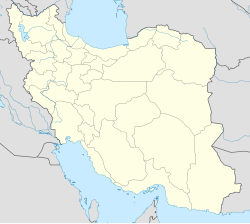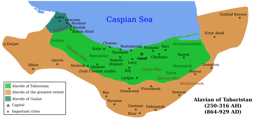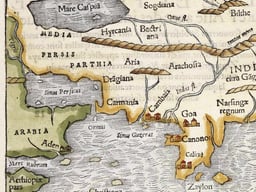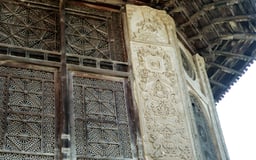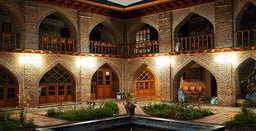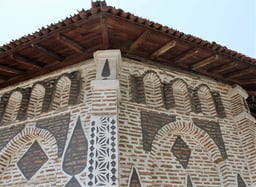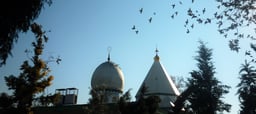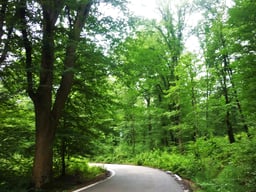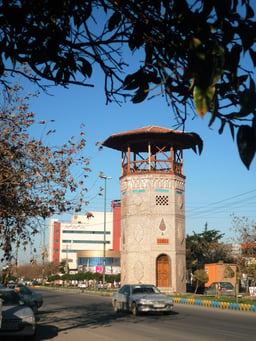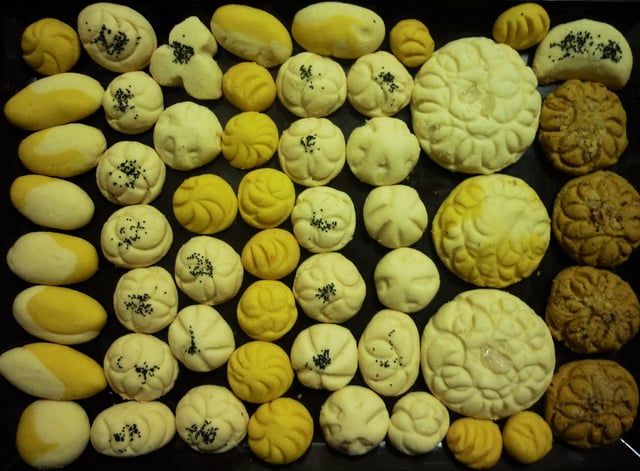Amol
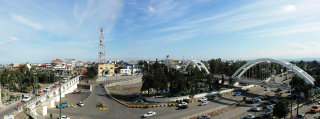
Amol

Amol آمل(in Persian) | |
|---|---|
City | |
| Ancient names: Amard, Amerdad, Ameld, Amui, Homo, Tabaristan, Amele, Amol | |
| Coordinates:36°28′11″N 52°21′03″E [87] | |
| Country | |
| Province | Mazandaran |
| County | Amol |
| Bakhsh | Central |
| Incorporated (city) | 1923[1] |
| Government | |
| • Mayor | Mohammad Moghadas[1] |
| Area | |
| • City | 21 km2(8 sq mi) |
| Elevation | 76 m (249 ft) |
| Population (2016 census) | |
| • Urban | 237,528[2] |
| • Metro | 364,692 |
| Time zone | UTC+3:30 (IRST) |
| • Summer (DST) | UTC+4:30 |
| Postal code | 46131-46391[3] |
| Area code(s) | (+98) 11 |
| Website | Amol.ir [88] Amol.gov.ir [89] |
Amol is located on the Haraz river bank. It is less than 20 kilometres (12 mi) south of the Caspian sea and less than 10 kilometres (6.2 mi) north of the Alborz mountains. It is 180 kilometres (110 mi) from Tehran, and 60 kilometres (37 mi) west of the provincial capital, Sari.[4] Amol is a historic city, with its foundation dating back to the Amard.
Amol آمل(in Persian) | |
|---|---|
City | |
| Ancient names: Amard, Amerdad, Ameld, Amui, Homo, Tabaristan, Amele, Amol | |
| Coordinates:36°28′11″N 52°21′03″E [87] | |
| Country | |
| Province | Mazandaran |
| County | Amol |
| Bakhsh | Central |
| Incorporated (city) | 1923[1] |
| Government | |
| • Mayor | Mohammad Moghadas[1] |
| Area | |
| • City | 21 km2(8 sq mi) |
| Elevation | 76 m (249 ft) |
| Population (2016 census) | |
| • Urban | 237,528[2] |
| • Metro | 364,692 |
| Time zone | UTC+3:30 (IRST) |
| • Summer (DST) | UTC+4:30 |
| Postal code | 46131-46391[3] |
| Area code(s) | (+98) 11 |
| Website | Amol.ir [88] Amol.gov.ir [89] |
History
Pre-Islamic
Ammianus Marcellinus says the name the Amol city is derived from the people Amard.[6] Some historians have attributed it to the rise of the city during Tahmuras and casual meeting Fereydun.[7] In fact, Amol is one of the most ancient cities of Iran. A number of historians and geographers believe it was established in 1st millennium BC. Some historians have attributed the rise of the city during Tahmuras.[7]
Pishdadian and Amard

Map of the Median Empire (600 BC) showing the relative locations of the Amardian tribe
Some past historians have associated this ancient city with the periods of the Pishdadian dynasty and the Kayanian dynasty.
Amol is an old city, with a history dating back to the Amards. Amards were the people inhabiting the area before the arrival of Aryans, who had migrated to and settled on the Iranian Plateau from the late 2nd millennium BCE to early 1st millennium BCE. Many scholars believe that the city's name is rooted in the word Amard (Amui in Pahlavi). According to historical literature, Amol was the capital of Mazandaran, at least in the period starting from Sassanid Empire to the Ilkhanate dynasty of Mongol Empire. Though they are a Median tribe, Herodotus names a tribe called Mardians as one of the ten to fifteen Persian tribes in Persis. It is now known that the only distinction between the Median Amardians and the Persian Mardians is the 'a' in the beginning of Amardians, which would mean they are two different tribes. Elsewhere he says, one of the peoples who have trusted Darius I[8] Igor M. Diakonoff says, Amardian lived in the coasts of the Caspian Sea, in the distance of the Alban and Otia from the north and the Hyrcanian from the east. Strabo says about Amard people, the Mard wore black robes, had long hair and everyone was braver. He was also allowed to marry any women. In the history of the Persian Empire, the Mard were handsome, capable and brave persons presented in the heart of the army and were responsible to defense the commander.[9] The Amard helped Achaemenid in several battles including the invasion of Greece, the occupation of Sardis, the attack of Medes and at the Battle of Opis. The other theory about Amol via Ibn Isfandiyar says, at the request of wife Firoz Shah, he created a large and flourishing city named Amele.[10]
Achaemenid Empire
Further evidence of the power of the Amol people is their fighting in the Battle of Thermopylae, Battle of Gaugamela and other Sardis forces in the Achaemenid Empire.
Parthian Empire
During the age of the Parthian Empire, Amol was one of the centers of Iran. It seems that Amol's reputation in the time of Alexander the Great and the Parthian period dominated the political-administrative Satrap was Hyrcanian.
Sassanian

Silver gilt dish of Tapuria, 7th–8th centuries. A tradition initiated under the Sasanians and continued after the Arab invasions. Anuzhad inscription in Pahlavi script, next to the reclining figure. British Museum
According to historical literature, Amol was the capital of Mazandaran during the period starting from the 3rd century CE under the Sassanian Empire to the 13/14th century CE under the Ilkhanate dynasty of Mongol Empire.
Based on evidences, including the coins found during excavations in addition to Muslim historical books, Amol was the capital of Mazandaran province during the Sassanid Era. According to historical literature, Amol was the capital of Mazandaran during the period starting from the 3rd century under Sassanian Empire to the 13/14th century under the Ilkhanate dynasty of Mongol Empire. On Sasanian coins, coin cities where there has been abbreviated name is known, but mark m was Amol. During the Bahram V Amol were Central of Iran and at during the Khosrow II and Dabuyid dynasty capital Mazandaran. Amu Darya Sasanian mid pers river about 2,500 km long, regarded in ancient times as the boundary between Iran and Turan, the modern name may be derived from Amol.[11] In city during this period has Temple, Market, fireplace there was.[12]
Islam
Amol, in the era of the Alid dynasties and Marashis dynasty, was the capital of Northern Iran. The inhabitants of Amol embraced Islam during the reign of Mahdi (775–785), the Abbasid Caliph. Amol was also the capital city of the Bavand dynasty and Ziyarid dynasty.
Today, Amol is a thriving modern metropolis. In the Abbasid Caliphate of the ninth century, Amol was one of the largest cities in Iran. Khalid ibn Barmak built a palace in the city and ruled for years. People from the Qarinvand dynasty arrived a couple of years and fought with the Abbasid Caliphate to win the kingdom.
In Hudud al-'Alam, Amol is regarded as a great city with active commerce and trading ventures.[13] However, resentment with the Tahirids rule increased due to the oppressive activities of their officials. People of the provinces pledged alliance to Hasan ibn Zayd. Zayd became the founder of the Zaydid dynasty of Tabaristan Alavids government in Tabaristan established and its with Amol centered and 106 year domination of the Abbasids in the territory ended.[14] Yaqub ibn Layth the was geostrategy in Amol. Hasan al-Utrush with trip to Amol who re-established Zaydid rule over the province Tabaristan in northern Iran in 914, after fourteen years of Samanid rule. After the Alid dynasty, the Ziyarid dynasty ruled Iran and Tabaristan. At this time Amol was developed in such a way that geographers have written articles about the industry and its silk.[15] The subsequent Afrasiyab dynasty flourished in the late medieval, pre-Safavid period; it is also called the Kia dynasty. It was founded by Kiya Afrasiyab, who conquered the Bavand kingdom in 1349 and made himself king of the region, in Amol.[16][17]
Safavid
In time of the Safavid rulers of Mazandaran, Amol experienced a period of growth. The city was the favorite dwelling of Abbas II of Persia, who often frequented it. At the time Amol was considered "the capital of the inhabited world" and acclaimed for its grandeur. Several bridges were built in the area, across the Haraz river, at this time.
in town was founded through trade center position and business centers already exceeded and founded artillery. The town has spacious and well-supplied bazaars and post and telegraph offices. Excavations in Amol at Hall of Fame have uncovered glazed ceramic and glass belonging to Islamic and modern periods[18] But after the Mongol invasion, the region was subject to devastation and it was during this time that Sari was declared as capital. In the beginning of the 7th century, Hessamedin Ardeshir, shifted the capital from Sari to Amol and constructed his palace there. Amol recovered a certain measure of prosperity while ruled by the Marashiyan and the Safavids under the latter it was a center of the province of Mazandaran. Since then it has never played a leading part in Persian national affairs, being surpassed in population by Babol and by the administrative capital of the province Sari, it has also suffered at various times from earthquakes. In continuation, Haraz River crosses the city of coal and iron mining region of Amol much iron can also have it in the past.[19]
Afsharid
Qajar
In the Qajar era, road and railway from Tehran to Amol, Amol was pulled from Mahmoudabad. Ibn Hawqal says, the geographers of the 4th to 10th century describe Amol great prosperity and prosperity, in the latter respect, according to Ebn Ḥawqal, it surpassed Qazvin. Its inner city was protected by a moat, and the houses were constructed of wood and reeds rather than mud bricks on account of the heavy summer rainfall. Rice, fruits, and vegetables grew profusely, and the town was a center for the fabrication of wooden articles, textiles, and carpets, the silks being especially famous. Amol port on the Caspian was the little town of named Ahlam or Ahlom.[21] James George Frazer in his travelogue to Amol says, the city truly great and vast. people were decent and respectable inhabitants of the city. Several leaders of the Iranian constitutional revolutions of 1905 and 1911 hailed from Amol. Molla Ali kani, one Amoli reformist who led the people, had a great role in achievement to the goals of Iran's constitutional revolution. During this period, was built many homes in the city. Although today Amol has expanded greatly on both sides of the Haraz river, its functions are still the same as they were seventy or eighty years ago.[22] In the 19th century, Amol iron and iron goods were traded all over Iran and as far abroad as Baghdad and Damascus. Today, the main industries are food processing factories rice, minor woodworking shops and a few brickworks.[23] Although today Amol has expanded greatly on both sides of the Haraz river, its functions are still the same as they were seventy or eighty years ago. Besides being one of the county centers of the province of Mazandaran, it is a busy commercial center. In itinerary book says, Amol is a magnificent city with 4 gates, although there is no gate installed, namely Darvaze Tehran or Larijan, Barforosh, Talike Sar and Nour.[24]
20th century
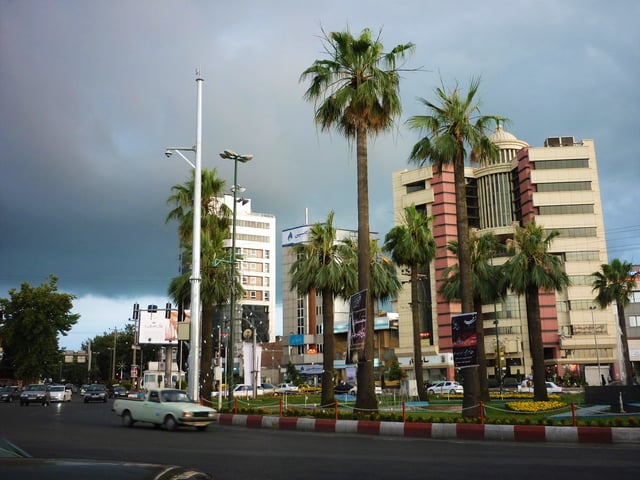
17 Shahrivar Square

Part of Haraz Street at night
Rabino described Amol as an open town with four gates, nine quarters, and approximately 2000 houses. A large bazaar contained about 400 shops with many traditional crafts and trades.
During the reign of Reza Shah Pahlavi, the face of the town was changed drastically. Schools and most of the streets and governmental buildings date from that era. The Jungle Uprising in 1982 of the Union of Iranian Communists (Sarbedaran) mobilized its forces to jungles around Amol and started some wars against the Iranian government in those jungles. It finally organized a famous uprising on 25 January 1982. This uprising was a failure and most of the UIC leaders were hanged but the uprising itself became very famous and is well respected among some Iranian Leftist organizations. This day became known in the Iranian calendar named Epic 6 Bahman.[25]
21st century
Some of the most recent projects have been the complete restoration of the Bazaar and of the Imam Reza street, as well as a comprehensive plan for the preservation of the old city quarters. A lot of different construction projects are currently underway, which intend to modernize the city's infrastructure. In the last few years, many square, towers, boulevards and bridge were built in Amol. Haraz Street one of the most modern streets of northern Iran. Amol is growingly turning into an industrialized town like most of the Iranian large cities. In Amol there municipality and special governor. Today, Amol is a thriving metropolis. One of the things they really lack is an airport so there are no cheap flights to Amol. Some of the most famous companies in Iran have main offices located in this city. Good secondary and tertiary education is being offered here as well. Islamic Azad University, for instance, is one of the biggest universities in the Middle East.[26]
Bitter events
The war between the Sassanid dynasty and Iran's owners in Amol and Amol Gullies were completely destroyed. Since Sasanian Empire then the town has suffered earthquake and flood damage several times, but each time has recovered, and it is still a considerable town.
Flooding in Mount Deryouk, and the destruction of entire city.
Dangerous diseases that plague the year 1198 AH
Mongol invasion of Genghis Khan and his descendants to Tabarestan
Wajih ad-Din Masud attack in Amol
Samanid attack on royan and Amol with Espahbodan
Timur war with the kings Marashis and killing people
Shah Ismail I and Shah Abbas Safavid wars attack the Amol and killing people
Agha Mohammad Khan Qajar attacked the larijan and Amol, killing people and destroy the city
In literature

The Battle History Of Mazandaran
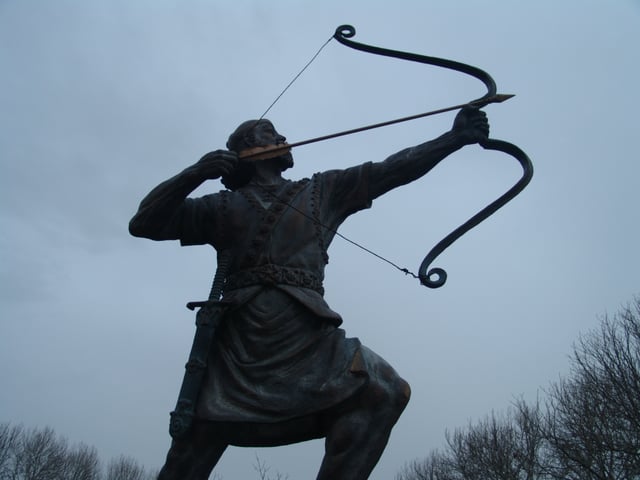
The statue of Arash the Archer
The first Aryan dynasty mentioned in Ferdowsi magnum opus at the Shahnameh. The name Amol has come up 16 times in Shahnameh. In the Persian epic, Shahnameh, Mazandaran is mentioned in two different sections. The first mention is implicit, when Fereydun sets its capital in a city called Amol:[27]
Hero iran Arash in Amol threw arrow to determine the Iranian border, Arash throw from the castle with Amol Aqaba and its agents to reach the border to have called Turan. The arrow flew the entire morning and fell at noon on the far bank of the Oxus River in what is now Central Asia.[28]
Geography

illustration part of town from a hill
The city has Mediterranean climate with very hot summers and cool and humid winters. Maximum rainfall is usually in the month of December and minimum in the month of July. Amol is located on the banks of the Haraz River (26 25'N 52 21'E) at an altitude of 76 m above sea. It is about 18 km from the Caspian Sea and about 10 km from the northern Alborz mountains. It is 180 km from the Iranian capital, Tehran, with a picturesque drive through Haraz Road. Sari the capital of Mazandaran is 70 km east of Amol. Mount Damavand (5610 m), the highest peak in the Middle East, is located south of Amol. Amol, with its elevated landscape and valleys, has dense forests. Its tall hills overlook the plains and stretch out till the high slopes of the Mount Damavand. The majestic and deep rocky valleys, rivers, numerous springs, elevated waterfalls, colorful vegetation, a variety of wild life, thermal springs, summer quarters, and rural settlements are some of the special factors which can prove attractive.[29]
Ecology
Amol has it lot of dense forests and pastures. The ecology of Tabaristan region had been an impediment to provide a regularly communicative path and Haraz path is one of the oldest ones that had communicated the north of Iran to the central plateau in different periods. This study attempts to deal with archaeological data of this communicative path in Sasanian period and at the beginning of Islam. A descriptive-analytical method and scaling archeological investigation in region has been used in the study.[30] the vegetation of the region can be divided into forest and grassland. Caspian horse It is also called Khazar Horse to be found the first time in Amol rediscovered in 1965 by Louise Firouz. also Mazandaran tiger there in the jungle Amol city.[31]
Coherent
Haraz Dam is the biggest dam north of Iran under construction on the Haraz River about 20 km from Amol of the year 2009 by Khatam-al Anbiya Construction Headquarter. It is a 150-meter earth rockfill dam with 8.6 million cubic meters of fill volume.[32]
JGC Corporation has also held talks to build a waste-to-energy plant, also known as waste incinerator, in the city of Amol in the northern Mazandaran Province.[33]
Climate
Amol has short, but hot summers, and long springlike winters. Köppen-Geiger climate classification system classifies its climate as hot-summer Mediterranean (Csa).[34]
| Climate data for Amol | |||||||||||||
|---|---|---|---|---|---|---|---|---|---|---|---|---|---|
| Month | Jan | Feb | Mar | Apr | May | Jun | Jul | Aug | Sep | Oct | Nov | Dec | Year |
| Average high °C (°F) | 13.1 (55.6) | 12.5 (54.5) | 12.4 (54.3) | 16.2 (61.2) | 23.7 (74.7) | 27.7 (81.9) | 28.7 (83.7) | 30.3 (86.5) | 25.9 (78.6) | 23.2 (73.8) | 18.9 (66.0) | 15.1 (59.2) | 20.6 (69.2) |
| Daily mean °C (°F) | 8.7 (47.7) | 8.1 (46.6) | 8.2 (46.8) | 11.9 (53.4) | 19.1 (66.4) | 21.9 (71.4) | 24 (75) | 25.4 (77.7) | 21.1 (70.0) | 18.4 (65.1) | 13.8 (56.8) | 10.2 (50.4) | 15.9 (60.6) |
| Average low °C (°F) | 4.4 (39.9) | 3.8 (38.8) | 4 (39) | 7.7 (45.9) | 14.6 (58.3) | 16.2 (61.2) | 19.3 (66.7) | 20.6 (69.1) | 16.3 (61.3) | 13.6 (56.5) | 8.7 (47.7) | 5.4 (41.7) | 11.2 (52.2) |
| Average precipitation mm (inches) | 96 (3.8) | 80 (3.1) | 74 (2.9) | 69 (2.7) | 31 (1.2) | 27 (1.1) | 27 (1.1) | 36 (1.4) | 87 (3.4) | 97 (3.8) | 97 (3.8) | 108 (4.3) | 829 (32.6) |
| Source: Climate-Data.org, altitude: 96m[34] | |||||||||||||
Excavation sites
In recent years, on the excavation hill Qaleh Kesh, some ancient jewelry was discovered. Radiocarbon analysis revealed the background of the jewelry and objects to date from the 1st millennium BC, Bronze Age. New to explore in Baliran works of the era found Paleolithic.[35]
Population
The population history of the city proper is as follows. All figures are official census figures from the Iranian Statistics Institute.[36]
| 1956 | 1966 | 1976 | 1986 | 1991 | 1996 | 2006 | 2011 | 2016 |
|---|---|---|---|---|---|---|---|---|
| 22,251 | 40,076 | 68,963 | 118,242 | 139,923 | 159,092 | 197,470 | 219,915 | 237,528 |
Breakdown of 2006 census:[5]
| Total | Male | Female | Family |
|---|---|---|---|
| 197,470 | 98,337 | 99,133 | 55,183 |
Language, religion, timeline
Most Amoli people speak the Mazandarani language Tabari as a mother tongue; however, Persian is the most common language spoken in Iran and the lingua franca. Northern provinces of Iran in the Parthian or Sassanid period, probably, was Zoroastrian. There is clear temples in the province. Mazandaran people converted to Islam around the second century AH. Amol as the first prime city center was a Twelver Shiite theocracy. At present, the majority of people are followers of Shia Islam. Amol, mazandaran has its own calendar months in addition to the official Tabari calendar of the moon, used in the era of Yazdgerd.[37]
Economy
Mineral water, meat, dairy, Wood and ingots the main production industrial are. Agriculture and Tourism are the basis economy Amol economic base is in its provincial products. Agriculture has always been a major part of the economy in and around Amol.
Amol is the economic center of Mazandaran province, with Agriculture and Tourism being the base of the Amoli economy. Rice, grain, fruits, cotton, tea, sugarcane, and silk are produced in the lowland. Mineral water, meat, dairy, wood and ingots are the main manufacturing industry.[38] 68% of exports of Mazandaran in Amol done. Plants, minerals, livestock and dairy products to be exported to countries Russia, United States, Iraq, Germany, Pakistan, Saudi Arabia, Turkey, Angola, Oman, United Arab Emirates and Azerbaijan.[39][40]
Rice
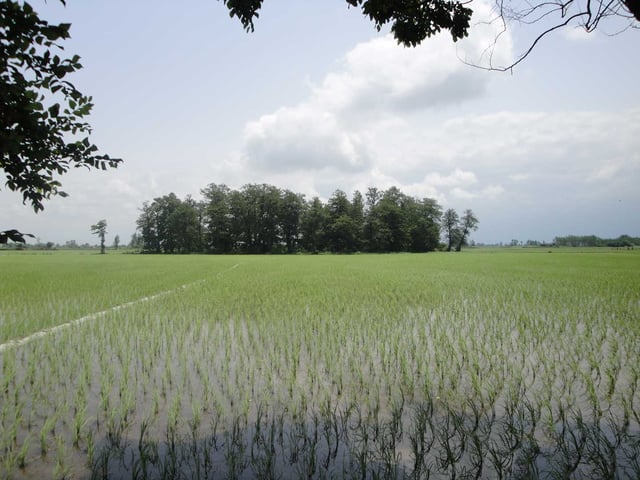
A typical rice paddy in the outskirts of Amol
The Rice Research Institute of Iran, Deputy of Mazandaran, has been established in 1963 and through its 50 years of research activity, it has had significant impacts on the rice cultivation in the region. Rice research of Iran location at Amol.[41] Winston Churchill stated that Tehran was supplied with rice by Mazandaran because of transportation facilities through the Amol. Amol rice is considered a high quality product and is exported across the world. Iran's rice export terminal at Amol was established 2016.[42]
Industry
Amol of primary cities in the production of bricks, tobacco, rice, paper and guns from thousands of years ago. Ultra Quality Rice and Fresh Fruits are major products of Amol Farmers. 65% Industry Mazandaran province in Amol. He is one of the centers meat and dairy products in Asia. Pottery is the material from which the potteryware is made, of which major types include earthenware, stoneware and porcelain. The place where such wares are made is also called a pottery. Pottery also refers to the art or craft of the potter or the manufacture of pottery.[43]Horticulture, greenhouse the city's other important activities. The company Solico that Including Kalleh dairy and Kalleh meat one of the biggest corporations in Asia located in Amol.[44] Currently, three industrial town is active in county named, Industrial Estate, Amol, Babakan Industrial Estate and Tashbandan.
Major corporations
Culture
Amol long history has ancestors because of intellectuals and local and national events. depending on the culture of the people some of the ancient ceremony of Mazandaran Islamic traditions mingled, Amol is a center for Iranian culture and has produced a number of famous poets. Wool, felting, felt hat production and mat weaving are part of the Amoli culture. Barf Chal, Lochu Wrestling, Palm and Tiregān named Damavand national day are local events held each year.Tirgan important celebrations in Iran's history.[53] Mazandaran music, art and writer from other parts of the city. Nowruz Iranians celebrate ancient is also important in Amol. Amoli people are said to spend much on books, clothes and food. They spend the leisure times going to cinemas, art exhibitions, music concerts and international book fairs that are being held in the city most of times in a year. Amol is known as the city of Mystics and philosophers, Hezar sangar, Productive and Alavian. Amol has been host Fajr International Theater Festival and Jasmine International Film Festival.[54]
Amol old city
Old district of Amol
The main body of the old city of Amol is located in the old bazaar Amol. The main constituents of the city Bazaar Amol known as Paein Baazar or Bazaar Chaharsogh situated in the city center, has lost some of its former importance due to social, economic and historical reasons. The roofs of the shops here are made of earthenware tiles on an incline so as to be a protection against the sun and rain. The open spaces within, are used to set up weekly bazaars. Historic mosque and old houses located along market and tribe quarters of the people is also available in the market. Tuesday era Sassanid, Qajar and contemporary is evident in the alleys of the market and its neighborhoods.[55]
Older neighborhoods
Historical and natural attractions

Pol-e No (lit. "New Bridge"), aka Moalagh Bridge
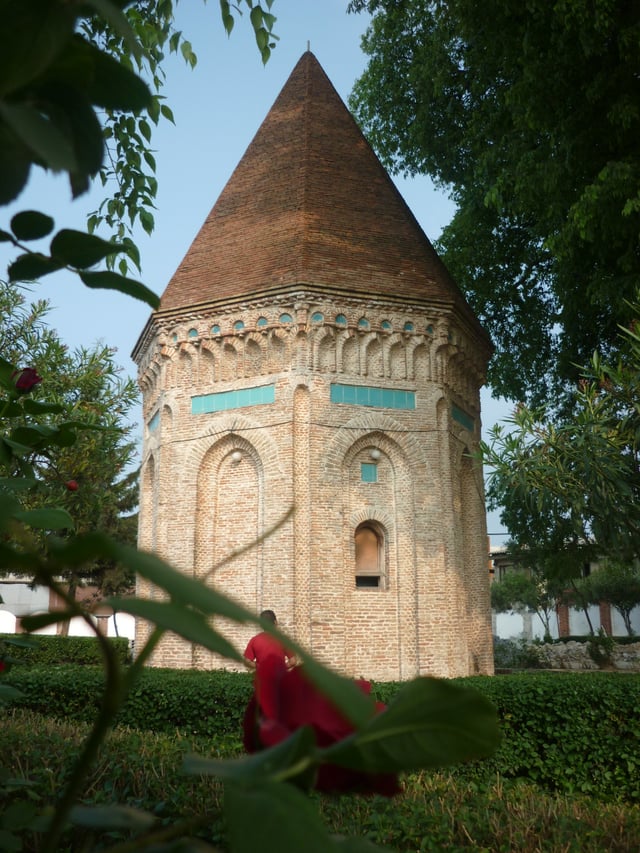
Tomb of Mir Haydar Amuli known as Seyyed Se Tan

Tomb of Mir-i Buzurg known as Mashad Mir Bozorg
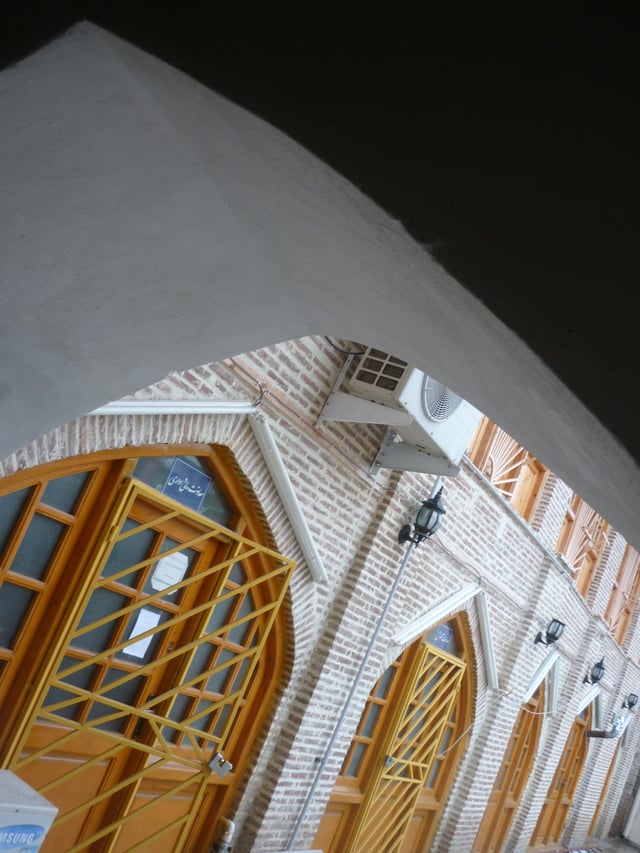
Jameh Mosque of Amol
In City and County:
Damavand Mountain is a stratovolcano which is the highest peak in Iran and the Middle East. It has a special place in Persian mythology and folklore.
Mausoleum of Mir Bozorg (Tomb of Qavam al-Din Marashi)[56]
Lar Dam
Lar National Park
Mosque of Hasan Al-Utrush. Originally a small tomb tower before renovation.[57]
Sayyid Haydar Amoli (Seyyed Se Tan Tomb tower)[58]
Moalagh Bridge
Davazdah Cheshmeh Bridge
Shahandasht Waterfall
Amol Bazaar[59]
Museum of History
Imamzadeh Ibrahim
Malek Bahman Castle
Nassereddin Shah relief (Shekl-e Shah)
Jameh Mosque of Amol
Agha Abbas Mosque
Yakhi Waterfall
Dokhaharan lake
Waterfall Deryouk
Shah Abbasi Baths
Fire Temple of Amol (known as Shams Al-Rasol)
The Sasanian Road
Tower Khidr Nabi
Tomb of Sultan Shahabuddin
Village forest Blairan
Village forest Alimastan
Gol-e Zard Cave
Ashraf Bath[60]
Inn Kemboja
House Manouchehri
House Shafahi
Heshtl Tower
Mirza Muhammad Ali Mosque
Kahrud Castle
Sangi Bridge Polour
Imam Hassan Askari Mosque
Imamzadeh Qasem Shrine
Imamzadeh Abdollah Shrine[61]
Mohammad Taher Shrine[62]
Ab ask Thermal Springs[63]
Lake Sahon
Haj Ali Kochak Mosque
Ab Murad Waterfall
Sang Darka Waterfall
Dehkadeh Talaei Park
Amoloo Mineral Water Spring
Forest Park Mirza Kuchak Khan Haraz
Forest Park Halumsar
Castle Kahrud
Larijan Thermal Spring
Hosseinieh of Amol
Gabri Tower
Mir-Safi Baths
Tomb Darvish Sheikh Ismail
Robat Sangi Polur
Prairie anemone of Polur
Ziaru Jungle
Haj Ali Arbab House
Do Berar Peak
Ancient Hill Qaleh Kesh
Larijan Thermal Spring
Kolakchal Mountain
Ghoredagh Mountain
Municipal House
Tekyeh Firuz Kola
Pol-e Mun Castle
Saghanefar Hendoukola
Saghanefar Zarrin Kola
Tekyeh Oji Abad
Souvenir
Rice (Berenj)
Tursu (Torshi)
Vegetable (Sabzi)
Kilim (Gelim)
Pottery (Sofalgari)
Juglans (Gerdoo)
Orange (Porteghal)
Cherry (Gilas)
Apple (Sib)
Wood carving (Monabat Kari)
Honey (Asal)
Felt (Namad)
Fruit preserves (Murabba)
Local Bread (Nan Mahali)
Pastry Ab dandan
Pastry Aqooz kennak
Pastry Saghe aroos
Naz Khatoon
Abe Narenj
Pisgendele
Yogurt dalal
Halva native
Food
Kateh
Kabab torsh
Tah Chin
Halva
Peshte Zik
Alu Mosema
Morghe Torsh
Shami Goosht
Ash-e Doogh
Khoresht Aloo
Mahi Shekam Por (Stuffed Fish)
Morgh Shekam Por (Stuffed Chicken)
Ordak Shekam Por (Stuffed Duck)
Ispina-Saek
Ashure
Transportation
Air base
Amol is an air base with two helicopters relief Hilal Ahmar. This is the first center of Iran's air rescue.[64]
By car and bus
Amol the largest urban boulevard and highways within mazandaran in the city is. are five bus terminals, Terminal international firuzi,the largest terminal in North of Iran is. Also offers an extensive bus route throughout the entire municipality as well as numerous public and private taxi services.
Road

Haraz Road
[[INLINE_IMAGE|//upload.wikimedia.org/wikipedia/commons/thumb/a/a4/Road77.png/18px-Road77.png|//upload.wikimedia.org/wikipedia/commons/thumb/a/a4/Road77.png/27px-Road77.png 1.5x, //upload.wikimedia.org/wikipedia/commons/thumb/a/a4/Road77.png/36px-Road77.png 2x|Road77.png|h33|w18]]
Haraz Road (Road 77) is the most important road from Tehran to northern Iran (province of Mazandaran) besidesKaraj-Chaloos. This road passes from the valley of Haraz river and therefore is also known as Haraz Road between Amol and Rudehen. Haraz road is the nearest road to Mount Damavand, the highest peak in Iran and Middle East. Lar National Park is accessible via this road. The road is the shortest route from Tehran to the north (180 km). In recent years, some parts of the road have been widened and safety has been improved. other road link with other cities Mahmoudabad, Nour and Babol.
Street and boulevard
Imam Reza Street
Haraz Street
Taleb Amoli Street
Nour Street
Mahdieh Street
Muhammad ibn Jarir Tabari Street
Mostafa Khomeini Street
Enghelab Street
Ayatollah Mahmoud Taleghani Street
Janbazan Street
Laleh Street
Farhang Street
Heravi Street
Ayatollah Modares Street
Amin Tabarsi Street
Shahid Beheshti Street
Basij Street
Velayat Street
Pasdaran Street
Azadegan Street
Khazar Street
Science
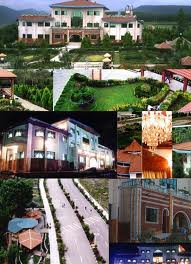
Shomal University
In the 11th century, Nizam al-Mulk, in his famous book named Siyasatnama, recommended creation of modern institutions by the name of Nezamiyeh with academic status in the large cities of the Islamic world, such as Balkh, Baghdad, Damascus, Neishabour and Bukhara the name of Amol was also included among them. Most of Allameh the scientific world are born in this city and the cultural capital of the world is Amol. Gold and copper have been expensive and time-old Amol has been the commercial center Iran.
This branch of Pasteur Institute of Iran is located in the city of Amol in the state of Mazandaran. This institute comprises different departments. Amol and Tehran stable hosted of Special Modern Technologies USERN.
Colleges and universities
Some of the biggest universities of Iran such as Shomal University are situated in Amol.
Amol has three universities:
Shomal University Most of the Middle East
Amol University of Special Modern Technologies the first and only state University of Amol
Islamic Azad University of Amol International University The big University Middle East
Haraz University of Amol[66]
Amol.ac[67]
Mazandaran 5[68]
Green University[69]
PNU Amol[70]
Sama College[71]
Doctor College[72]
INSTITO Pasteur D, Iran of Amol[73]
Samangan institute[74]
Sport
Wrestling, Volleyball, Handball, Futsal, Basketball, Boxing, Race car, Mountaineering, Bodybuilding, Karate, Taekwondo and Kung Fu Popular sports in Amol. Kalleh Mazandaran is a volleyball club based in Amol, Asian Club Champions 2013, currently competing in the highest tier of the Iranian volleyball classification, the Iranian Volleyball Super League. Kalleh a Most Popular in Iran and Asia. Kalleh Sports Club also has a basketball team named Kalleh Basketball and Young team volleyball named Kalleh Javan.[75]
Wrestling and volleyball
Amol is the birthplace of many popular Wrestlers and Volleyball athletes. Notabl Athlete from Amol include like, Ghasem Rezaei Olympic gold and bronze medalist and Adel Gholami player in national team.[76]
Stadium
Payambar Azam Arena one of the most important venues Iran
Chamran Stadium
Kalleh Stadium
Host
2007 WAFF Futsal Championship
West Asian Basketball Championship
International Fajr Championships 2018
International Conference of Sport Science 2017
FIVB Volleyball Coaches Course Level II held in Iran 2018
Media
The early in Amol published many newspapers and publications ever since the constitution was a major strength in Mazandaran province. Now, several newspapers and weekly print is active.
Notable people

Hassan Hassanzadeh Amoli

Abbas Mirza

Abu Sahl Al-Quhi

Haydar Amuli

Ghasem Rezaei

Ali Larijani
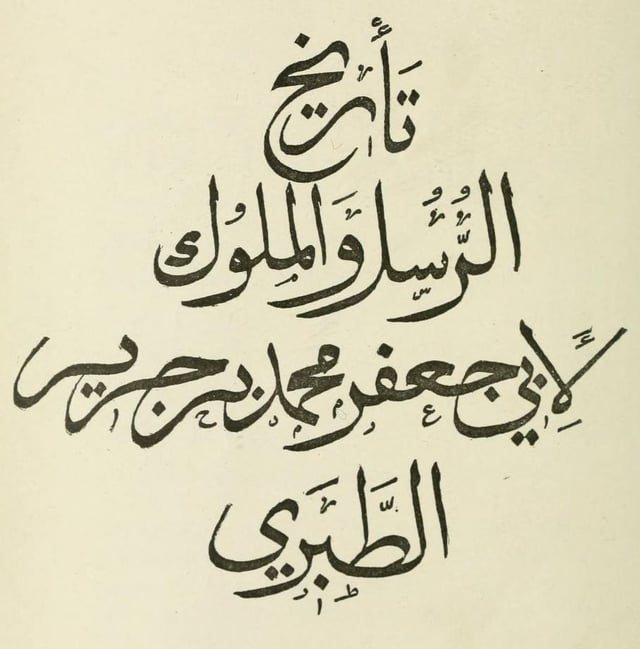
Al-Tabari
Muhammad ibn Jarir al-Tabari (839–923) – Historian
Arash the Archer – Legendary hero
Ali Larijani (b. 1958) – Politician
Taleb Amoli (b.7th century) – Persian poet
Ghasem Rezaei (b. 1985) – Wrestler
Hassan Hassanzadeh Amoli – Philosopher and theologian
Abdollah Javadi-Amoli (b. 1933) – Cleric
Sahl Ibn Bishr (9th century) – Jewish astrologer
Ali ibn Sahl Rabban Tabari (9th century) – Medieval physician
Abu-Sahl Quhi (10th century) – Medieval astronomer and physicist
Abolhassan Tabari (10th century) – Medieval physician
Fakhr ad-Din ar-Razi (1149–1209) – Theologian and philosopher
Ahmad Moshir al-Saltaneh (1260–1337) – Prime minister
Abdolali Lotfi - Politician and judges
Farhang Sharif (b. 1931) – Musician
Ibn Isfandiyar (13th century) – Historian
Seyyed Hayder Amuli (1319–1385) – Shi'ite mystic and Sufi leader
Muhammad ibn Mahmud Amuli (14th century) – Medieval physician
Omar Tiberiades (8th century) – Medieval astrologer
Rustam al-Tabari – Imami theologian
Manouchehr Khosrodad - Major general
Abbas Mirza (1789–1833) – Qajar crown prince of Persia
Mohammad-Taqi Amoli (1887–1971) – Cleric
Hashem Amoli (1899–1993) – Cleric
Iskandar-i Shaykhi (14th century) – Afrasiyab dynasty Ruler
Mohammad Taqi Daneshpajouh (1911–1996) – Scholar
Yahya ibn Abi Mansur (832) – Astronomy
Haseb-i Tabari (1092–1108) – Astronomy
Abdolhossein Navaei (1923–2004) – Historian and writer
Zahiruddin Marashi (1413–1488) – Historian
Sheikh Khalifa Mazandarani – Sarbadars leader
Massoud Monfared Niyaki – Major general
Abul-Abbas Qassab Amoli – Mystic
Imad al-Din al-Tabari – Scientist
Cheragh Ali Khan Navaei - Politician
Ibn Furak – Theologian
Ghassem Hashemi Nezhad - Literary critic and writer
Iraj Malekpour – Physics
Gholam-Ali Soleimani – Manager
Mulla Ali Kani (1267–1306) – Learned
Siraj al-Din Qumri (b. 1368) Persian poet
Mohammad-Ali Mirza Dowlatshah (1789–1821) – Qajar prince
Iraj Malekpour (b.1941) – Physicist
Abdol-Qader Gilani (1078–1166) – Sufi leader
Mohammad-Javad Larijani (b. 1951) – Politician
Al-Lalika'i (14th century) – Mufti
Hossein ibn Ebrahim Tabari (10th century) – Medieval physician
Fatemeh Javadi (b. 1959) – Politician
Sadeq Larijani (b. 1960) – Cleric and Politician
Bagher Larijani (b. 1961) – Physician
Fazel Larijani (b. 1953) – Master
Adel Gholami (b. 1986) – Volleyball player
Seyyed Razi Larijani – Scientist
Khalifeh Soltan – Statesman and cleric
Al-Nagawri – Persian physician
Mohammad Ali Sadjadi (b. 1957) – Director
Muhammad Sharif Mazandarani – Faqih
Abbas Amiri – Actor
Sufi Mazandarani – Poeter
Kazem Amoli - Doctor
Mohammad Javad Fazel - Writer
Ahmad Seif - Economists
Ibn Qass - Writer
Ahmad Akhgar - Politician
Abdullah Khan Ahmadieh - Doctor
Masoud Forootan - Actor
Mahmoud Motaghedi - Writer
Mahasti Bahreini - Writer
Ibrahim Khawas – Sufi
Abul-hasan Shamsabadi - Faqih
Mohmmad Ali Daei - Writer
Mashallah Ajoudani – Historian
Narjes Emamgholinejad – Shooting
Hamed Shiri – Football player
Allahyar Sayyadmanesh – Football player
Health centers and hotels

Shomal Hospital
Municipality Hotel (Hotel Shahr)
Oxin Hotel
Olympic Hotel
Niloofar Hotel
Shomal Hospital (Medical tourism)
Imam Khomeini Hospital
Imamreza Hospital
17 Shahrivar Hospital
Imam Ali Hospital
Peyman Hospital
Nik Darman Hospital
Attractions
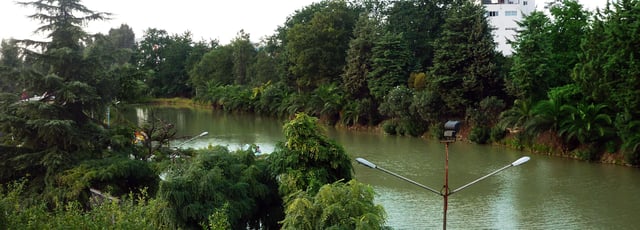
Artificial lake Dehkadeh Talaei Park

Representatives of Ayandeh Bank in Amol
In Amol there's famous bank representatives
Amol has a large amusement park in the name Dehkadeh talaei park
Most restaurants in the province there at Amol
The city has two Cinemas, Several central library and Three museums is
Distance
Away with some of the major cities in Iran:
| City | Km distance |
|---|---|
| Sari | 69 |
| Tehran | 189 |
| Ramsar | 181 |
| Mashad | 811 |
| Astara | 477 |
| Kerman | 1158 |
| Ahvaz | 1001 |
Sister cities
[[INLINE_IMAGE|//upload.wikimedia.org/wikipedia/commons/thumb/3/32/Flag_of_Pakistan.svg/23px-Flag_of_Pakistan.svg.png|//upload.wikimedia.org/wikipedia/commons/thumb/3/32/Flag_of_Pakistan.svg/35px-Flag_of_Pakistan.svg.png 1.5x, //upload.wikimedia.org/wikipedia/commons/thumb/3/32/Flag_of_Pakistan.svg/45px-Flag_of_Pakistan.svg.png 2x|Pakistan|h15|w23|thumbborder flagicon-img flagicon-img]] Lahore, Pakistan[77]
[[INLINE_IMAGE|//upload.wikimedia.org/wikipedia/commons/thumb/2/21/Flag_of_Vietnam.svg/23px-Flag_of_Vietnam.svg.png|//upload.wikimedia.org/wikipedia/commons/thumb/2/21/Flag_of_Vietnam.svg/35px-Flag_of_Vietnam.svg.png 1.5x, //upload.wikimedia.org/wikipedia/commons/thumb/2/21/Flag_of_Vietnam.svg/45px-Flag_of_Vietnam.svg.png 2x|Vietnam|h15|w23|thumbborder flagicon-img flagicon-img]] Cần Thơ, Vietnam

